Haemangioma
Haemangioma Definition:
This is a swelling due to congenital malformation of blood vessels. It is an example of Hamartoma.
They are classified into three types:
- Capillary,
- Cavernous,
- Arterial.
Capillary Haemangioma
This arises from capillary tissue. Hence, it commonly occurs in the skin, They can be of the following types:
- Salmon patch is a bluish patch over the forehead, in the midline, present at birth and disappears by 1 year of age. Hence, no treatment is required.
- Port wine stain (naevus flammeus) is an extensive intradermal haemangioma. This is bluish-purple in colour, commonly affects the face or other parts of the skin, is present at birth and usually does not progress.
- Port wine stains are common on the shoulder region, neck and buttocks. These areas represent the junction between the limbs and the trunk.
- As the child grows, by 5–6 years of age the swelling regresses.
- Strawberry angiomas produce swelling that protrudes from the skin surface. The child is normal at birth. After a month, a bright red swelling appears over the head and neck region, which exhibits signs of compressibility. The lesion consists of immature vascular tissue. Even though the lesion grows initially, by 5–7 years of age, swelling regresses and colour fades. Hence, no specific treatment is necessary. The treatment is indicated only when the swelling persists.
Read And Learn More: Clinical Medicine And Surgery Notes

Venous Haemangioma—Cavernous Hemangioma
This occurs in places where venous space is abundant, for example lip, cheek, tongue, and posterior triangle of the neck.
Posterior Triangle Clinical features
- History of swelling in the neck of long duration. A history of bleeding is present when it occurs in the oral cavity.
- The swelling is warm and bluish in colour but not pulsatile.
- Soft, fluctuant, transillumination is negative.
Capillary Haemangioma
- Skin and soft tissue involvement
- Salmon patch: Midline—Forehead
- Port wine stain: Head and neck
- Strawberry angioma: Compressible
- Wait and wait-and-watch policy is the best
Cavernous Haemangioma
- Compressible swelling
- Bluish warm, non-tender swelling
- Associated with arteriovenous communication
- Associated with lipoma—Naevo lipoma
4. Compressibility is present. This sign is also called ‘sign of emptying’ or ‘sign of refilling’. When the swelling is compressed between the fingers, blood diffuses under the vascular spaces and when pressure is released, it slowly fills up. Compressibility is a diagnostic sign of haemangioma.
Differential diagnosis
- Lymphangioma is brilliantly transilluminated. If a lymphangioma is infected or has been treated with preliminary injections, it may not show transillumination.
- Lipoma is not compressible.
- Other cystic swellings — cold abscess
Hemangioma Baby
Posterior Triangle Treatment Of Cavernous Haemangioma
Principles
- Injection is the first line of treatment of cavernous haemangioma. It makes the swelling fibrotic, less vascular and smaller. Thus, excision can be done at a later date.
- Excision of haemangioma in the oral cavity is more difficult than in the neck.
- It is better to have control of the external carotid artery in the neck while excising haemangioma in the oral cavity. If necessary, the external carotid artery should be ligated in order to control the bleeding.
- Adequate blood to be arranged
- Previous embolisation into the feeding artery decreases the size of the haemangioma (therapeutic embolization).
- Large haemangiomas in the oral cavity should be excised only after preliminary sclerotherapy and taking all the precautions mentioned above.



Complications Of Haemangioma
These have to be kept in mind especially while operating. Otherwise, uncontrollable bleeding can occur resulting in hypotension and shock.
Syndromes Associated With Haemangioma
Congenital Arteriovenous Fistula (Arterial Haemangioma)
An abnormal communication between artery and vein results in AV fistula.
Injection Line Of Treatment
- Boiling water or hypertonic saline
- Sodium tetradecyl sulphate (S.T.D. solution)
- In multiple spaces, in multiple sittings
- Aseptic thrombosis and fibrosis occur
Swellings—Treated With Sclerosants
- Haemangioma
- Haemorrhoids
- Partial prolapse rectum
- Oesophageal varices
- Varicose veins

Complications Of Haemangioma
- Ulceration and Bleeding: Commonly occurs with capillary haemangioma
- Infection: Septicaemia usually precipitated by a small ulcer
- High output cardiac failure haemangioma of the liver
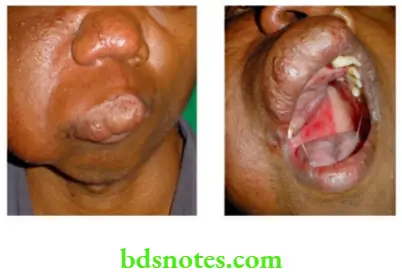
Such AV fistula has structural and functional effects.
Hemangioma Baby
Structural effect
Since high-pressure blood from an artery flows into the vein, the veins get dilated, tortuous and elongated — arterialisation of the vein, results in secondary varicose veins.
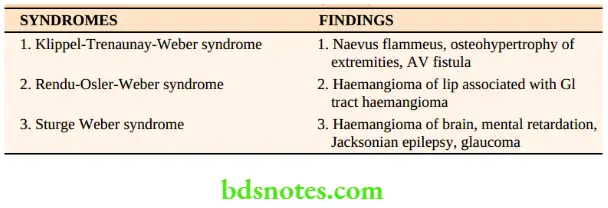
Arteriovenous Fistula—Types
- Congenital
- Traumatic
- Iatrogenic—Done in cases of renal failure
Physiological effect
Increased pulse rate, increased cardiac output, and increased pulse pressure result due to increased venous pressure and arteriovenous shunt.
Functional effect
- Soft, cystic, fluctuant, transillumination negative, pulsatile swelling.
- A continuous bruit/murmur is characteristic.
- Nicoladoni sign or Branham sign
- On compressing the feeding artery, the venous return to the heart diminishes, resulting in a fall in pulse rate and pulse pressure.
- Also, on compressing the feeding artery, pulsation or continuous murmur may also disappear and swelling will diminish in size.
- If the AV fistula is big, a high-output cardiac failure can occur.
- The affected part is swollen (because of high pressure) — local gigantism. Thus, overgrowth of the limb or toe can occur.
- Distal to the AV fistula, there are ischaemic ulcers, due to comparative reduction in the blood supply.


Investigations
Angiography with DSA (Digital Subtraction Angiography) pictures are essential before treating these patients.
Posterior Triangle Treatment
Therapeutic embolisation is the treatment of choice for arteriovenous fistula, in congenital cases.
Acquired lesions need to be observed or treated by quadruple ligation.
Hemangioma Baby
Cirsoid Aneurysm
- Not an aneurysm.
- It is an AV fistula occurring in older people affecting the temporal region.
- The arteries and the veins are dilated and tortuous and are compared to a pulsating bag of worms.


Cold Abscess In The Posterior Triangle
Posterior Triangle Causes
- Posterior cervical lymph nodes primarily involved — route of infection from adenoids or with other lymph nodes in the anterior triangle.
- Lower posterior lymph nodes or scalene node — route of infection from lungs.
- From tuberculous cervical spine — Caries spine.
Caries Cervical Spine
- Clinically it presents as pain in the back, cold abscess and neurological presentation.
- Rust’s sign: A child with a caries spine will support the head by holding the chin.
- Cold abscess from the caries spine can rupture anteriorly or posteriorly.
Anterior Rupture
It ruptures deep to a prevertebral layer of deep cervical fascia from where it can take the following routes:
- Upper cervical region — Presents as a deep-seated abscess in the posterior wall of the pharynx in the midline.
- Lower cervical region – Pus will press on the oesophagus and trachea forwards.
- Laterally pus passes deep to the prevertebral fascia behind the carotid sheath in the posterior triangle.
Haemangioma Treatment
Posterior Rupture
Pus may enter the spinal canal and then can travel along the anterior primary division of the cervical spinal nerves.
Diagnosis
- Cervical spine X-ray to rule out spinal tuberculosis
- Chest X-ray to rule out pulmonary tuberculosis
- Nondependent aspiration of the cold abscess followed by AFB staining.
Posterior Triangle Treatment
- Anti-tuberculosis treatment
- Non-dependant aspiration if cold abscess is present
- Please refer to orthopaedic books for specific treatment of TB spine.
Differential diagnosis
- Haemangioma
- Lymphangioma.
Secondaries In The Lymph Nodes Or Lymph Node Metastasis In the Head And Neck
Very often, the patients present to the surgeon with lymph node swelling in the neck with or without any complaints. If there is an obvious lesion in the oral cavity, the diagnosis is easy. On the other hand, difficulty arises in locating the primary malignancy, which is hidden or occult. It is important to know the anatomical location of the lymph nodes in the neck and the drainage area so that drainage areas can be investigated.
Lymph Node Metastasis In the Head Classification
They can be divided into horizontal and vertical groups of lymph nodes. Interestingly, very often circular groups of nodes are enlarged in non-Hodgkin’s lymphoma on both sides.
Vertical Group Of Lymph Nodes
They can be classified into central and lateral groups of lymph nodes. Most of the central group of lymph nodes are in relation to laryngeal cartilages or the trachea. The lateral lymph nodes are the most popular lymph nodes called deep cervical nodes. The majority of them are in close relationship with an internal jugular vein. Jugulo-omohyoid and jugulo-digastric lymph nodes belong to this category.
The details about the vertical group of lymph nodes are given.
Haemangioma Treatment
Present Nomenclature Of Various Groups of Lymph Nodes
- Level 1: Lymph nodes in the submandibular triangle, submental nodes
- Level 2: Upper jugular nodes: From posterior belly of digastric superiorly to hyoid bone inferiorly.
- Level 3: Middle jugular nodes: from hyoid superiorly to cricothyroid membrane inferiorly.
- Level 4: Lower jugular nodes: From cricothyroid membrane superiorly to clavicle inferiorly.
- Level 5: Posterior cervical region: From anterior border of trapezius posteriorly to posterior border of sternocleidomastoid anteriorly and clavicle inferiorly.
- Level 6: Anterior compartment nodes: From hyoid bone superiorly to suprasternal notch inferiorly and laterally by the medial border of the carotid sheath.
- Level 7 Upper mediastinal nodes: Inferior to suprasternal notch.

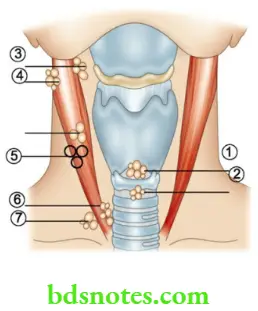
- It is advisable to know these various levels of lymph nodes and their drainage areas.
- When block dissection is being done, you will find the lymph nodes being mentioned in the form of levels.
- Example: In papillary carcinoma thyroid, level III, level IV, level V and level VI lymph nodes are removed.

Clinical Presentation Of Metastatic Deposits
- The majority of patients are elderly males (> 50 years), who present with painless swelling in the neck of a few months duration.
- The symptoms with which a patient presents to the hospital give the clue to the site of origin of the primary. A few examples are given below.
-
- Difficulty in swallowing: Carcinoma posterior 1/3 tongue, oropharyngeal carcinoma or carcinoma oesophagus
- Difficulty in breathing: Laryngeal cancer
- Hoarseness of voice: Larynx or thyroid
- Obvious growth in the oral cavity: Carcinoma cheek, alveolus, tongue, etc. Haemoptysis, difficulty in breathing: Bronchogenic carcinoma
- Epistaxis, ear pain or deafness: Nasopharyngeal carcinoma.
Clinical Signs
- Lymph nodal metastasis appears as a hard, nodular or irregular mass in the anatomical location of the lymph nodes.
- Early cases may have some mobility. However, in the majority of cases nodes get fixed and they attain a huge size. Very often, what appears as one lymph node, is a complex mass of multiple lymph nodes.
- On the sternomastoid contraction test or chin test, these nodal swellings become less prominent. Skin ulceration is a late feature. A prominent skinfold is due to infiltration into the platysma —platysma sign.
- The primary malignancy may be evident in the anterior third of the tongue, cheek, alveolus, etc.
- The posterior one-third of the tongue should be palpated with a gloved finger.
- Secondaries in the lymph nodes can cause pressure effects or may cause paralysis of nerves. Upper anterior deep cervical lymph nodes can cause hypoglossal nerve paralysis. The tongue points towards the side of the lesion.
- When there is no evidence of the primary lesion clinically, the situation is described as occult primary with secondaries in the neck. Pain in the distribution of the trigeminal nerve (face) suggests nasopharyngeal malignancy infiltrating the skull base (foramen lacerum).
Nasopharyngeal Carcinoma—Trotter’s Triad
- Conductive deafness
- Homolateral Immobility of soft palate
- Pain in the side of the head due to the involvement of the 5th cranial nerve
Occult Primary Sites
- Posterior 1/3 of the tongue
- Oropharynx
- Nasopharynx
- Sinuses
- Upper oesophagus
- Bronchus
- Thyroid
How do you Suspect Metastasis in the Neck?
Any elderly patient presenting with firm to hard lymph nodes with or without fixity.
Having Suspected Metastatic Deposits, Remember the Following Facts
- 80% of them are metastatic deposits.
- The majority of malignant neoplasms are epithelial in origin.
- Nodes in the upper half: Levels 1 and 2: can be due to primary in the oral cavity, tongue, oropharynx, and larynx.
- Nodes in the lower half: Levels 3 and 4 can be due to primary in the thyroid, and tongue.
- Nodes in the supraclavicular region: Level 5: GIT, genitourinary tract and lungs and nasopharyngeal carcinoma
- Nodes in the pretracheal, suprasternal region: Level VI: Papillary carcinoma thyroid.
Occult Investigations
- Compete blood picture
- Chest X-ray can give the following information:
- Secondaries in the lungs with cannonball appearance as in cases of malignant melanoma of the head and neck.
- Bronchogenic carcinoma can be suspected by an irregular dense shadow in the peripheral lung fields.
- Large mediastinal node mass may be seen, with or without tracheal shift.
- Biopsy from the clinically obvious lesion (tongue, cheek, etc.).
- Triple endoscopy includes:
- Direct and indirect laryngoscopy
- Oesophagoscopy
- Bronchoscopy and suspicious areas can be biopsied
- X-ray base of the skull may show destruction of the bone by the tumour.
- CT scan of the sinuses, nasopharyngeal area, or skull base to detect a primary growth, its extension, etc.
- FNAC of the lymph nodes can give a diagnosis in more than 90% of the cases. Avoid insertion Biopsy as it will result in tumour recurrence and wound necrosis.
- If the primary tumour cannot be detected on endoscopy, a blind biopsy is taken from the posterior wall of the fossa of Rosenmuller and of the pyriform fossa on the same side.
- When aspiration cytology is negative, an excision biopsy is advised as a last resort.
Lymph Node Metastasis In the Head Treatment
When the primary tumour is obvious with enlarged lymph node metastasis, radiotherapy is the preferred line of treatment. However, management of oral malignancy.


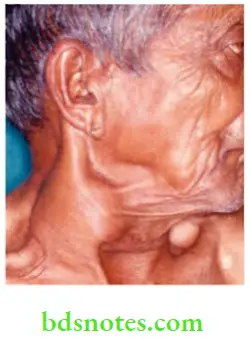



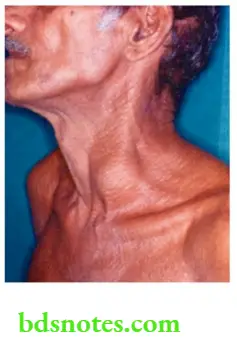
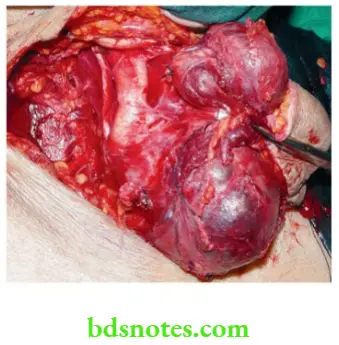
Clinical Examination In A Case Of Lymph Nodes In The Neck
- Lymph nodes—all groups
- Drainage areas
Pressure effects on:
- Hypoglossal nerve
- Accessory nerve
- Cervical sympathetic chain
2. Treatment of occult primary with metastatic lymph nodes:
- If the lymph node or nodes are mobile, radical block dissection is done and if the histopathologic report detects poorly differentiated carcinoma, extra-capsular spread, or nodes are large (> 3 cm) radiotherapy is given.
- If there is a large, bulky secondary, bilateral secondaries or fixed secondaries, radiotherapy is given to the neck masses. If the nodes do not completely regress and the tumour becomes bigger in size after 6–8 weeks of radiotherapy, radical neck dissection would be considered.
Different Types Of Neck Dissections
1. Radical Neck Dissection (RND)– CRILE: Here all the cervical lymph nodes from Level 1 to Level VI are removed along with nonlymphatic structures such as sternocleidomastoid muscle, internal jugular vein, accessory nerve (XI), the submandibular salivary gland and cervical sympathetic
Plexus: A few examples where radical neck dissection is done are carcinoma tongue, oropharyngeal carcinoma, etc.
2. Modified radical neck dissection or Functional neck dissection (BOCCA). In this, all the lymph nodes from Level I to Level VI are removed but non-lymphatic structures are preserved (mentioned above): Done for papillary carcinoma thyroid.
3. Selective neck dissection: Here any of the lymphatic compartments is preserved (which should have been removed as a part of classic RND). A few examples:
- Supraomohyoid dissection: Removal of nodes in Levels 1, 2 and 3 done for carcinoma oropharynx, and carcinoma cheek.
- Lateral neck dissection: Levels 2, 3, and 4 are removed as in carcinoma larynx.
- Posterolateral neck dissection: Levels II to V are removed as in cutaneous malignancy of posterior scalp and neck.
4. Commando’s operation: RND, hemimandi-bulectomy with radical glossectomy: It is a very radical aggressive surgery done for a carcinoma tongue.
Follow-up
- About 30–40% of treated patients with occult primary with metastatic nodes die with no evidence of the primary later.
- In about 30% of patients, the primary will manifest within 1–2 years time.
- About 10% of patients are cured but once again primary is not found out.
Pancoast’S Tumour
- Pancoast’s tumour or superior sulcus tumour is a bronchogenic carcinoma arising from the apex of the lung.
- Typically, the patient is an elderly male around 70 years, a chronic smoker who presents with cough, weight loss, dyspnoea and chest pain.
- As the tumour grows, it compresses the lower roots of brachial plexus C8 and T1 and results in tingling, pain, and paraesthesia in the distribution of an ulnar nerve.
- The tumour is felt in the posterior triangle, in the lower part. It is hard in consistency, fixed, irregular and sometimes tender. The lower border of the mass cannot be appreciated.
Pancoast’s syndrome refers to the following components:
- Pancoast tumour
- Erosion of the first rib
- Paralysis of C8 and T1 nerve roots
- Horner’s syndrome is due to paralysis of the cervical sympathetic chain. The preganglionic sympathetic fibres of the head and neck are given from the 1st and sometimes the 2nd thoracic segments of the spinal cord. These nerve fibres synapse with the cells in the three cervical sympathetic ganglia. They give postganglionic fibres to the head and neck region.
Thus, anywhere along this pathway, disruption, damage or infiltration of the nerve roots results in Horner’s syndrome. The causes of Horner’s syndrome are depicted.
Components Of Horner’s Syndrome
- Miosis: Small pupil
- Anhidrosis: Absence of sweating
- Pseudoptosis: Drooping of the upper eyelid
- Enophthalmos: Regression of the eyeball
- Nasal vasodilatation: Nasal congestion.
Horner’s Syndrome Investigations
- Chest X-ray: This may demonstrate a dense mass or collapse of the lobe, etc.
- A CT scan may demonstrate infiltration of the tumour into ribs or vertebra.
- Sputum for malignant cells.
- Flexible bronchoscopy: Tissue biopsy or sputum sample can be collected.
- FNAC of the tumour gives the diagnosis in the majority of cases.
Horner’s Syndrome—Common Causes
- Posterior inferior cerebellar artery thrombosis (PICA)
- Cervical sympathectomy
- Pancoast’s tumour
Uncommon Causes
- Syringomyelia
- Injury to lower roots of brachial plexus
- Tumour in the neck
- Aneurysm of carotid artery

Different Types Of Neck Dissection Treatment
Palliative radiotherapy: The response rate is poor.
Examination Of Swelling Introduction
Swelling refers to the enlargement of an organ or tissue. For example; thyroid swelling means enlargement of the thyroid gland, and parotid swelling means enlargement of the parotid gland. Even though swelling mass and lump are more or less synonymous, it is better to say—swelling in the neck, mass in the abdomen and lump in the breast (rhymes better–it is like telling the boy is handsome and the girl is pretty).
- Broadly they are classified into solid swellings, cystic swellings and pulsatile swellings. This will help to sort out the swellings immediately. These are very interesting short cases which can be diagnosed often by history, a few by inspection alone a few by palpation and others by auscultation.
- Have a broad idea about the origin of these swellings. Kindly go through the 2 classifications given below before examining these patients.
- What is the cause of this swelling?
-
- Is it congenital? Haemangioma, lymphangioma, dermoid cyst, branchial cyst myelomeningocele
- Is it traumatic? Haematoma, Av fistula
- Is it inflammatory? Boil, Carbuncle, chronic abscess
- Is it neoplastic? Soft tissue tumours: Lipoma, neurofibroma
- Is it tuberculous? Cold abscess
- Is it parasitic? Cysticercosis.
If it is a cystic swelling, what is the cause of the cyst?
Patient Data
They are recorded such as name, age, place, occupation, admitting complaints, etc.
History
- Site: Where is the swelling? In many cases, when the patient points to the site of the swelling diagnosis can be made. Here are a few examples.
- Dorsum of the hand: Ganglion
- Outer canthus of the eye: External angular dermoid cyst
- Nape of the neck: Carbuncle
- In front of the tragus of the ear: Parotid swelling
- Flanks: Lipoma (Commonest site)
- What is the duration of the swelling?
It is but natural when a patient says I have a swelling, first question should be to ask duration— when did you notice this swelling first? A few swellings are present since birth, a few may have a long duration and a few may have a short duration. Examples are given as follows.
Present since birth
- Lymphangioma–cystic hygroma
- Dermoid cysts and branchial cysts. Very often they present in late teens.
- Haemangioma
- Hamartomatous leisons
Present for a few years
- Congenital—Branchial cyst
- Benign tumours: Lipoma, neurofibroma, dermoid cysts, sebaceous cysts,
Present for a few months
- With pain, short duration — inflammatory — carbuncle
- Without pain, short duration — malignant — soft tissue sarcoma
3. Mode of onset: How did the swelling start? Insidious onset: When a patient says I cannot recollect any special time or occasion, it is insidious onset. Often thyroid swellings, benign tumours, and malignant tumours present as insidious onset. During the routine course of bathing, the patient might have noticed the swellings such as lipoma or neurofibroma. Very often others point out thyroid swellings.
- After trauma: Did you have any trauma? Fractures, dislocations, and haematomas appear after trauma. Implantation dermoid cyst develops in the palms, fingers, soles and toes after sharp injury. Traumatic AV fistula develops after trauma. Keloids and hypertrophic scars develop over-vaccination sites.
- With fever: Any swelling which appears along with fever is an inflammatory swelling such as pyogenic abscess (common in diabetics) boil or carbuncle.
4. Do you have a fever?
Fever and swelling together suggest inflammatory pathology such as abscess carbuncle, etc. Fever for many days and recent swelling may suggest tuberculosis of lymph nodes. Lymph node swellings in the neck with fever can also be found in Hodgkin’s lymphoma.
Swelling and fever together
- Boil
- Carbuncle
- Cellulitis, lymphangitis
5. Do you have pain?
Pain and swelling of short duration suggest inflammatory swellings. The causes have been mentioned above.
Nature of the pain
- Dull aching pain: stretching of the capsule
- Throbbing pain: Abscess
- Referred pain: Patients with parotid swellings may complain of itching or discomfort in the ear.
- Swelling first and pain later indicate the following situation.
-
- Infection in a sebaceous cyst—secondary infection
- Infection in a branchial cyst—secondary infection
- Benign tumour transforming into malignant tumour—Lipoma into Liposarcoma
- Malignancy infiltrating nerves or bones
6. How is the progress of the swelling? Is it rapidly growing? or slow-growing or stationary.
- Rapid growth in 1–2 months is suggestive of malignancies.
- Rapid growth within 5–10 days is not from malignancy but from inflammatory swellings.
- Slow growing for many years, 2–5 years is typically seen in lipoma, thyroid swellings and parotid swellings
- Slow growth and remain static: Few lipomas, and neural tumours may exhibit this property.
- Slow growth for many years and recent rapid growth indicate malignant transformation of a benign lesion. A few examples are given below:
-
- Lipoma–Liposarcoma
- Neurofibroma–Neurofibrosarcoma
- Multinodular goitre (Thyroid swelling)–carcinoma thyroid
7. Does the swelling regress in size?
- Inflammatory swellings will regress in size with treatment as happens in breast abscess or mastitis.
- Deeply situated abscess in the thigh may mimic sarcoma but diminishing size is a strong indication of inflammatory pathology.
8. Are there any other symptoms associated with swelling?
- Discomfort or tingling on pressure: Neurofibroma
- Recurrent bleeding after minor trauma: Haemangioma
- Whitish discharge — non-foul odour: Cold abscess
- Whitish discharge with foul odour: Sebaceous cyst
9. Are there any other similar swellings elsewhere in the body?
- If present they indicate multiple lipomatosis or multiple neuro-fibromatosis.
- Multiple lymph node swellings in multiple sites are typical of Lymphoma.
- Sudden appearance of multiple cutaneous nodules may indicate metastasis and lymphoma (T-cell type)
10. Any changes in the swelling?
- Skin ulceration and foundation are typical of malignancy infiltrating the skin
11. Does the swelling recur after surgery?
- Benign tumours will not recur if they are completely excised. But if it is not removed properly or incompletely, they may recur. Example sebaceous cyst. If a part of the sebaceous cyst wall is left behind, it will recur but not immediately but many months or years later. A few benign tumours have the property to recur. They are desmoid tumours, ganglion and pleomorphic adenoma if it is enucleated.
Benign Swellings Which Recurr After Excision
- Desmoid tumour
- Adamantinoma (jaw tumour)
- Ganglion
- Sarcoma
- Pleomorphic adenoma (after enucleation)
- Past history, personal history and relevant family history should be asked for
Recurrence is the nature of malignant tumours even when they are removed with wide excision. A classical example is soft tissue sarcomas.
Local Examination Inspection
Students should resist the temptation of palpating the swelling as soon as they see the swelling. Careful observation will help you with the diagnosis in many cases.
Location
- Dermoid cysts occur in the line of fusion such as in the outer canthus of the eye, midline, etc.
- The most common site of a ganglion is the dorsum of the hand over scapholunate articulation
- Plexiform neurofibroma classically occurs over the distribution of ophthalmic division of the trigeminal nerve.
- The classical location of the branchial cyst—half in front and half behind the sternocleidomastoid is unremarkable.
- The typical site of the carbuncle is the nape of the neck.
Number
- A few swellings can be multiple such as
- Sebaceous cysts in the scrotum scalp or back
- Multiple lipomatosis
- Multiple neurofibromatosis
- Lymph node swellings as in Lymphoma, tuberculosis, infectious mononucleosis
- Multiple abscesses —(pyaemic) in diabetic patients—they are very tender.
Extent, size and shape
- Describe the extent from where to where in both transverse and vertical directions. Whenever possible describe in relationship to the bony landmark.
- When you describe size, use the word approximately measuring about.
- Few swellings have some characteristic shapes. Examples:
-
- Sebaceous cyst: Hemispherical
- Thyroglossal cyst: Vertically placed oval swelling
- Subhyoid bursitis: Horizontally placed oval swelling
- Dermoid cysts: Spherical or oval
Surface and borders
- Smooth: Branchial cyst, dermoid cyst — the majority of cystic swellings have a smooth surface and round borders
- Irregular: In cases of malignant tumours
- Nodular: Multinodular goitre is classically had nodular surface
The skin over the swelling
- Erythematous: Inflammatory swellings such as boil, carbuncle, and abscess Red shiny: Soft tissue sarcoma
- Pigmentation: May be present over the skin of neurofibroma — it is brownish in colour
- Blackish pigmentation is suggestive of mole or naevus
- Dilated veins: Suggest increased vascularity as in soft tissue sarcoma
- Bluish colour, port wine colour may indicate haemangiomas
- Blackish spot—punctum is pathognomonic of epidermoid Cyst (Sebaceous cyst).
Pulsations
- Aneurysm: Will exhibit expansile pulsations — Popliteal aneurysm in popliteal fossa, carotid aneurysm in the carotid triangle, innominate aneurysm in supra sternal space of Burns. Please remember these 3 sites are also the sites of an abscess. Hence, carefully examine these areas rule out pulsations and double-confirm before incising swellings in these locations.
- AV fistula: Most often you will see this in the nephrology ward (fistula done for renal failure for dialysis)
- A pulsating tumour in the neck is a carotid body tumour.
Movement with deglutition
This should be checked only when swelling is in the midline of the neck. Swellings which are attached to or fixed to the trachea or larynx move with deglutition (more details are given in the thyroid chapter).
Following are swellings which move with deglutition
- Thyroid swellings
- Thyroglossal cyst
- Subhyoid bursitis
- Pre-tracheal and laryngeal lymph nodes
Movement on protrusion of the tongue
This test also should be checked only when swelling is in the midline of the neck. Thyroglossal cyst classically moves on protrusion of the tongue.
Pressure effects
Pressure effects are common due to a swelling or lymph nodes which gets enlarged in cases of malignant tumour.
A few examples are given below.
- Metastatic lymph node mass in the neck can give rise to paralysis of nerves — Hypoglossal nerve paralysis, cervical sympathetic paralysis (Horner’s syndrome)
- Soft tissue sarcoma in the arm can give rise to radial nerve paralysis.
Surrounding area
Mention if any abnormality is found such as pigmentation in neurofibroma or oedema in inflammatory swellings, etc.
Palpation
- Local rise of temperature and tenderness should be checked first under palpation. Inflammatory swellings such as abscesses will exhibit these signs — not found in cold abscesses.
- Size and shape have to be mentioned.
- Again confirm surface and borders under palpation — smooth, irregular or nodular. The cauliflower-like appearance of the surface is characteristic of epithelioma — squamous cell carcinoma
- Borders:
- Round and distinct in benign swellings such as branchial cyst, thyroglossal cyst, and neurofibroma.
- Edge slips under palpating fingers in a case of lipoma. This is a pathognomonic sign of lipoma, called a Slip sign.
- Consistency:
- Soft: Lipoma and cystic swellings are soft.
- Firm in cases of lymph node swellings, and neurofibroma.
- Hard in metastatic nodes, bony swellings such as cervical rib and malignant swellings. A malignant swelling is not only hard but also indurated. Induration means hardness due to a desmoplastic reaction caused by the tumour.
- A hard thyroid nodule can be malignant.
- Putty consistency: This is specially described for sebaceous cysts. They have sebum as content hence they have the consistency of toothpaste.
- Variable: Sometimes, swelling may have variable consistency such as a few areas being hard and a few areas may be soft or firm. You should be in a position to explain why variable consistency. An example is given below: A large multinodular goitre may have areas which are hard — could be due to malignant changes or due to calcification and a few areas which are soft due to degeneration of the nodule. Variable consistency is also a feature of sarcomas when grows rapidly because of tumour degeneration or tumour necrosis.
- Rubbery consistency has been mentioned for lymph nodes in Hodgkin’s lymphoma.
Pedunculated soft swelling arising from the skin is pedunculated papilloma
- Fluctuation: It should be done only when swelling is soft — to find out whether swelling contains fluid or not.
Following are a few rules of the fluctuation test- It should be done when the swelling is soft
- Mobile swelling has to be fixed–first, fix the swelling.
- Index and thumb from both hands are used. The index finger to press the swelling (active finger) and the thumb will be raised (Passive finger).
- Fluctuation should be elicited in both directions. Because thigh muscles can be fluctuant in the horizontal direction but not vertically (In the line of fibres).
- When the swelling is small, i.e. less than 2 cm, Paget’s test is done. Use the index finger and press in the centre of the swelling. If it is soft, it is a cyst. Cystic swellings will feel soft in the centre and firm at the periphery and solid swelling vice versa.
- Transillumination test: Swellings having clear fluid will transilluminate but those with blood (Haemorrhage or haematoma) or pus (Abscess) or thick contents such as cold abscess (Tuberculous) will not.
- This test should be done in a dark room
- A pen torch is used to illuminate the swelling in one corner and look at the other side with illuminoscope (An X-ray sheet is rolled in) and observe whether the light is seen or not. Avoid surface transillumination.
- If the transillumination is positive, it is a cyst with clear fluid inside. Following are differential diagnosis
A. Cystic hygroma — sites are the neck, axilla and groin because lots of lymphatic tissues are present in these areas.
D. Ranula — swelling in the floor of the mouth.
- Intrinsic mobility:
- Hold the swelling and gently move in horizontal and vertical directions. The majority of the subcutaneous swellings–dermoid cysts, neurofibromas, lipoma, etc. have free mobility.
- Restricted mobility is one of the early features of malignant tumours such as soft tissue sarcoma.
- Also, deep-seated (Deep to deep fascia or deep to muscles) benign tumours may exhibit restricted mobility., especially when muscles are contracted.
- Bony swellings are unmistakably immobile. For example: Chondroma, cervical rib, metastasis in bones.
Almost all the cystic swellings in the skin, subcutaneous tissue or in the deeper plane are benign and as a rule, they should have free mobility. However, this is not true due to various anatomical factors.- Branchial cyst: Restricted mobility is due to its adherence to the sternomastoid muscle.
- Thyroglossal cyst: Transverse mobility is absent because the cyst is tethered by the remnant of the thyroglossal duct.
- Sebaceous cyst: Limited mobility due to the adherence to the skin at the summit.
- All malignant tumours exhibit a property of local infiltration. They also cause a lot of desmoplastic reactions resulting in fibrosis. As a result of this the lump may not freely and they have restricted mobility. Students should look for this sign carefully because often this may be the only important sign available for the diagnosis.
- A few examples are given below
- Restricted mobility in a thyroid nodule suggests carcinoma thyroid
- Restricted mobility in a soft tissue swelling suggests soft tissue sarcoma
- Restricted mobility in a hard node in the neck suggests malignancy.
- Sign of compressibility: The swellings which have communication with tissue spaces or cavity give the positive sign of compressibility. Thus, a steady pressure is applied over the swellings. The swelling may disappear completely or may partially disappear. However, when pressure is released the swelling fills up slowly. Hence, it is also called the ‘sign of refilling’.
Examples are Cavernous haemangioma and lymphangiomas.
Reducibility: We say hernias are reducible. It reduces into the peritoneal cavity means they have been displaced into a different area. It requires coughing or straining for it to reappear. Whereas, compressible swellings reappear when compression is released. - Plane of the swelling
- Contract the muscles in the region of the swelling. If swelling becomes more prominent, it is superficial to the muscles. For example: Subcutaneous lipomas in the forearm become more prominent when flexors are contracted.
- Sometimes when the underlying muscle is contracted, swelling may remain the same size but mobility may be restricted, This is either because swelling is arising from muscles or swelling is infiltrating muscles as in a soft tissue sarcoma.
- Almost all significant cystic swellings in the neck are deep to deep fascia. Thus, contracting the sternomastoid for laterally placed swellings and bending the chin against resistance for centrally placed swellings must be done to define the plane of swelling.
- Sebaceous cysts are attached to the skin at the site of the punctum.
- Pulsations
Pulsations over the swelling are found in vascular swellings.
They are of 2 types.- Expansile: Aneurysms are characterised by expansile pulsations. When two fingers are placed over the swelling on the sides, the fingers are not only elevated but are also separated. Popliteal aneurysms typically give this sign.
- Transmitted: When the swelling is situated over a vessel, the fingers are raised but not separated. Example: Jugulodigastric lymph node over the carotid artery.
- When the swelling pushes the vessel anteriorly, transmitted pulsation can be obtained as an example. cervical rib pushing the subclavian artery.
- Pulsation can also be present in vascular tumours such as osteogenic sarcoma or secondaries from carcinoma thyroid, etc.
- Any pressure effects
- Especially in cases of limbs. Generally, benign swellings do not give rise to oedema or wasting of the muscles but malignant swellings do.
- A few examples are given below.
- Sarcoma of the limbs may give rise to venous oedema distally
- Sarcoma can also result in nerve palsy, which may give rise to the wasting of muscles.
- Examination of regional lymph nodes
- Significant lymph nodes palpable are suggestive of malignancy. Nodes larger than 2 cm, firm or hard with or without restricted mobility are suggestive of malignancy. Sometimes that may be the only vital clue for the diagnosis.
Few Clinical Methods Of Examination Of Swelling

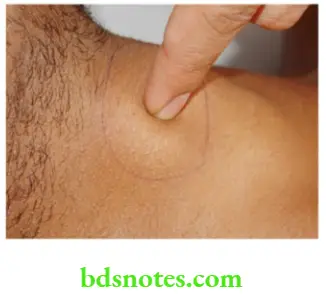




Clinical Diagnosis
- Based on your findings give 1 diagnosis as clinical diagnosis and 2–3 as differential diagnosis (DD).
- When you give a DD, think of common anatomical structures in the locality and common diseases affecting those structures. Importantly give a DD which matches most of the findings. Examples: For a sebaceous cyst, the dermoid cyst can be the DD and for a cystic swelling another cystic swelling can be the DD.
- In the following pages, you will come across site-specific differential diagnosis.
Clinical Discussion
- If lipoma is hard it is liposarcoma.
- If lipoma is painful, it is neurolipoma and in cases of adiposis dolorosa.
- If the lipoma is vascular, it is myelolipoma.
- Lipoma does not get infected because it is relatively avascular.
- Lipoma arborescens is a benign lipomatous mass which occurs most often in the knee joint.
- An abdominal emergency in a Lipoma is intussusception.
Effects Of Aneurysm—Tips
- Thrombosis
- Ischaemia
- Pressure
- Skin Changes


Effects Of Aneurysm Some Useful Tips
- Thrombosis: It Is one of the common effects of aneurysm particularly aortic and popliteal resulting in ischaemia in the distal territory.
- Ischaemia: Distal parts may become gangrenous and or can have ischaemic ulcers or claudication.
- Pressure effects
- Effect on bone: Erosion of the vertebral body as In aortic aneurysm (this does not happen in TB spine).
- Effect on nerves: Popliteal aneurysm can give rise to foot drop due to pressure on the lateral popliteal nerve.
- Effect on the veins: Results in congestion and oedema of the leg
- On the oesophagus: Dysphagia as in aortic aneurysm.
- Skin changes may be in the form of oedema and redness.







A dangerous complication of a lipoma is liposarcoma. a few retroperitoneal lipomas and lipomas in the thigh can turn into liposarcoma after many years of growth. Malignancy should be suspected when the swelling grows rapidly, it becomes painful due to infiltration of nerves, The swelling becomes vascular and red-coloured with dilated veins over the surface. The surface is warm due to increased vascularity, skin fungation or fixation occurs later. Mobility gets restricted because of infiltration into deeper planes such as muscle.
Leave a Reply